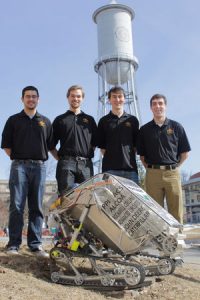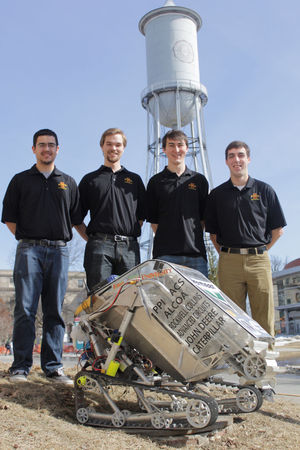Everything is silent. The surface is cold and dusty and over the horizon — Earth and beyond.
Neil Armstrong and Buzz Aldrin were able to feel what it’s actually like to traverse the moon’s surface, but a group of ISU students is now trying to do the next best thing — send their new creation to the moon in their stead.

The ISU Lunabotics Club, led by Garret Schieber, senior in mechanical engineering and president of the Lunabotics Club, is working on a completely automated machine that has the potential of opening a path to a trillion dollar industry via space mining and colonization.
Schieber’s team is one of 19 teams slated to compete at NASA’s 2015 Robotic Mining Competition.
The club’s results have been on the rise in recent years.
“It’s been a great ride these last four years,” Schieber said. “Getting to watch the club grow from a group that had no awards to a group with many, on top of being one of the best in the competition.”
When the time comes for these robots to be deployed into space, they will ride the new state of the art Orion spacecraft.
Once in space, they can be taken to the moon or even farther.
On the moon, the robots can begin paving the way for mankind.
Through the use of 3D printing, they will be able to start building shelters that will eventually be covered by lunar soil, which is called regolith.
The regolith will help shield the inhabitants from all the solar and cosmic radiation that would otherwise harm or even kill them.
The regolith itself contains small amounts of ice and oxygen, which can be used to help sustain a colony. It even contains a special isotope of Helium called Helium-3, which can be used as a high yielding energy source.
Once a lunar colony, so-to-speak, is established, there are many potential applications.
The moon could be used as a way point between Earth, Mars and beyond. The mining of elements that are rare on Earth, but abundant elsewhere, could potentially be a multi-billion or even trillion dollar industry.
The NASA competition focuses on the development of robotic mining technology, and ISU Lunabotics was the first club to have an autonomous one. NASA’s goal for this competition is to help generate research data, as well as raise public awareness through its outreach programs.
The team has currently devoted more than 3,000 human hours to the project and shows no sign of slowing down.
Lunabotics members said they are willing to put forth so much work because it is such a great experience.
“It is a great way for boosting future careers due not only to the actual work, but all the budgeting, formal documenting and outreaching that comes with it,” Schieber said.
The team’s outreach program is focused on raising public awareness and the education of children. The group participated in a presentation at Clive Elementary two weeks ago.
“The program has been very successful,” said Jessica Bales, senior in public relations.
Some politicians believe NASA, along with its missions and projects, no longer carries the same weight of importance that it once did and that tax-payer dollars should be reallocated somewhere else.
A little known fact is that much of the technology that we use today was first developed by NASA.
“We wouldn’t have solar panels without NASA,” Schieber said.
Putting a colonization plan into action is still a few years away.
Current estimates for when a robot will participate in the first mission range from around the year 2030 to 2035.
This story was originally written and published by Evan Howe at the Iowa State Daily.
